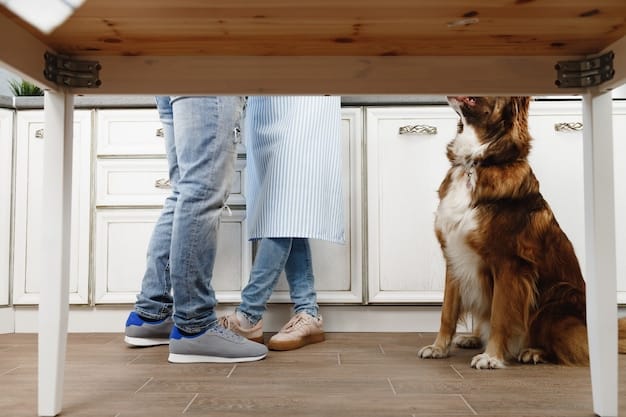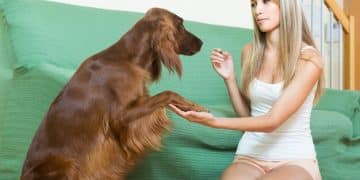Stop Counter Surfing: Train Your Dog for Calm Kitchens

Anúncios
Effective strategies, including positive reinforcement, training, and management, are key to stop counter surfing in your kitchen.
By using these strategies, you can ensure a safe, calm kitchen environment for both pets and owners. Consistent application will lead to positive results.
Anúncios
Training and environmental management are crucial in stop counter surfing. Understanding your dog’s motivations helps in addressing the behavior effectively.
Understanding Why Dogs Counter Surf
Understanding why Stop Counter dogs surf is essential. It’s rarely out of malice, but driven by instinct and learned behavior.
Dogs are scavengers by nature, and kitchen counters present an easy opportunity. The tempting smells and accessible food are too much for many dogs to resist.
Anúncios
They aren’t trying to misbehave; they’re following natural instincts. Dogs react to powerful olfactory stimuli and their sense of opportunity.
The Allure of Scent and Taste
Dogs have an incredibly strong sense of smell. What we barely notice is an intoxicating scent to them.
The scent of food, even small crumbs, can be irresistible. Once they get a taste, the behavior becomes reinforced.
This leads to repeated counter surfing, as the reward encourages further attempts. It’s important to manage these temptations effectively.
Attention Seeking and Boredom
Stop Counter surfing may also be a way to gain attention. Dogs might repeat the behavior, even for negative attention.
Boredom or lack of mental stimulation can drive this behavior. Dogs may look for their own entertainment, and kitchen counters are exciting.
Understanding these motivations helps in redirecting their focus. By managing their environment, we can teach alternative, acceptable behaviors.
Environmental Management: The First Line of Defense
Environmental management is the first step to stopping counter surfing. It involves proactively setting up the kitchen to prevent access.
By eliminating temptations, dogs won’t be able to practice counter surfing. This requires consistency and vigilance from all household members.
If they never get to jump and find food, they can’t learn that it’s rewarding. Ensuring success by preventing the opportunity is key to breaking the habit.
Clear the Counters Religiously
One simple and effective management strategy is to keep counters clear. Remove all food, dirty dishes, and even small objects like mail.
If there’s nothing on the counters, there’s no temptation for your dog. This reduces the chances of counter surfing significantly.
Make it a habit to clear up immediately after meal prep. This will prevent your dog from learning to associate the counter with rewards.
Restrict Access When Unsupervised
When you’re not supervising your dog, limit their access to the kitchen. This is especially important during meal preparation or when you leave the house.
Using baby gates, closed doors, or crate training can be effective. A “safe zone” for your dog keeps them occupied away from the kitchen.
These measures prevent counter surfing by eliminating access. Providing chew toys or puzzle toys will keep them mentally stimulated and calm.

Positive Reinforcement: Teaching What You Want
Positive reinforcement teaches dogs the behaviors we want to see. Instead of focusing on punishment, reward desired actions.
The goal is for your dog to learn that staying off counters leads to rewards. Patience and consistency are essential to this process.
High-value treats should be used to reward good behavior. This helps create positive associations with staying on the floor.
Rewarding “Four Paws on the Floor”
Reinforce the behavior of having all four paws on the floor. Start with minimal distractions and reward immediately when your dog stays on the floor.
Progressively reward them for staying near the counter but not jumping. This will help reinforce the behavior of staying calm in the kitchen.
Use high-value treats that your dog loves. This will motivate them to continue exhibiting the desired behavior.
Teaching “Place” or “Mat Training”
Teach your dog to stay in one spot with a “place” command. A designated mat or bed can provide a calm space for them during kitchen activities.
Reward them heavily when they stay on the mat. Gradually increase the time they stay there before rewarding them.
This training helps them learn to settle in one spot. It also provides an alternative behavior to counter surfing.
Impulse Control and “Leave It” Command
Developing impulse control is key for situations with temptations. The “Leave It” command helps dogs ignore tempting items and focus on you.
Impulse control is important for a well-behaved dog in many situations. The “Leave It” command is particularly useful in preventing counter surfing.
Training impulse control helps dogs make good choices, even in tempting environments. It’s a key component of good kitchen manners.
Training the “Leave It” Command
The “Leave It” command is trained in stages. Start with a low-value treat in your closed fist and tell your dog to “Leave It.”
Reward them immediately when they back off. Use a higher-value treat as a reward when they successfully ignore the item.
Gradually increase the challenge by placing treats on surfaces. Keep practicing to ensure they understand the “Leave It” command.
Applying “Leave It” in the Kitchen
Once your dog masters “Leave It,” practice in the kitchen. Start by placing non-food items on the counter and gradually introduce food.
Work up to more difficult scenarios with tempting foods. Reward them heavily when they successfully ignore the items.
“Leave It” will give you the tools to manage temptations. It builds impulse control, stopping counter surfing and promoting calm behavior.
Addressing Root Causes: Exercise and Mental Stimulation
Insufficient exercise and mental stimulation can lead to counter surfing. A bored or under-exercised dog will seek their own entertainment.
Provide adequate physical and mental challenges to reduce unwanted behaviors. A well-exercised dog is less likely to engage in counter surfing.
Mental stimulation, such as puzzle toys and scent games, helps keep dogs occupied. It ensures they don’t resort to counter surfing for fun.
Physical Exercise tailored to your dog
Each dog has different exercise needs based on their breed and energy levels. A high-energy dog will require more activity than a low-energy one.
Ensure your Stop Counter dog is getting enough exercise for their size and breed. This could include daily walks, playtime, or visits to the dog park.
Active play, like fetch or tug-of-war, can help burn off excess energy. This prevents them from using the kitchen counter as a source of entertainment.
Mental Stimulation and Enrichment
Mental stimulation is just as important as physical exercise. Dogs need to use their brains to stay happy and well-behaved.
Introduce puzzle toys and snuffle mats to engage your dog’s mind. Training sessions and scent games provide mental challenges that tire them out.
A mentally stimulated dog is less likely to engage in undesirable behaviors. They will be more focused and relaxed, reducing counter surfing.
Troubleshooting Common Challenges and Setbacks
Training isn’t always a smooth process. You might encounter setbacks, but persistence and patience are key to success.
Counter surfing is a habit, and breaking habits takes time. Don’t get discouraged if your dog relapses; it’s part of the learning process.
Stay consistent with your training and make adjustments as needed. Reinforce the positive behaviors and avoid punishment, which can cause fear.
Inconsistency and Lack of Generalization
Inconsistency is a common challenge in training. If different household members enforce different rules, your dog might get confused.
Ensure everyone in the household follows the same training protocol. Practice in various settings to help your dog generalize the behavior.
Gradually increase the difficulty by adding distractions. With consistent practice, your dog will learn to stay off counters.
Dealing with Relapses
Relapses happen and are part of the training journey. If your dog slips up, calmly redirect them to the desired behavior.
Avoid punishment, which can damage your relationship with your dog. Go back to basics and re-establish clear boundaries.
Addressing underlying factors like boredom or anxiety can help. With patience and consistency, setbacks can be overcome.
When to Seek Professional Help
If training challenges persist, consider professional help. Trainers can offer tailored advice for addressing counter surfing and other behaviors.
Professional trainers can identify triggers and offer effective strategies. They can guide you in reinforcing good behavior and overcoming setbacks.
Choosing a professional who uses positive reinforcement will ensure a good outcome. They’ll help you and your dog achieve a harmonious relationship.
Identifying When Professional Intervention is Needed

Consider professional help if progress stalls. If the behavior escalates or your dog is repeatedly eating dangerous items, seek guidance.
If you’re not seeing improvement, or the behavior becomes a safety concern, a trainer can provide valuable insight. Professionals are trained to handle these situations.
Professional help ensures a tailored approach to your dog’s needs. It can help you overcome challenges more quickly and effectively.
Choosing the Right Professional
When selecting a Stop Counter dog trainer, look for certifications and positive reinforcement methods. Avoid trainers who use punishment-based techniques, as these can harm your dog.
Ensure the trainer has experience with counter surfing and similar issues. Check references and reviews before committing.
A good trainer will involve you in the process and empower you to continue training successfully. Professional guidance can lead to lasting results and a stronger bond.
| Key Point | Brief Description |
|---|---|
| 🐾 Understand Motivation | Dogs counter surf due to instinct, scent, and learned reinforcement; it’s not malice. |
| 🚫 Environmental Control | Clear counters always and restrict kitchen access to prevent opportunities. |
| ✅ Positive Reinforcement | Reward “four paws on the floor” and train a “place” command for desirable behavior. |
| 🧠 Exercise & Mental Work | Adequate physical and mental stimulation reduces behavioral issues like counter surfing. |
Frequently Asked Questions About Stop Counter Surfing
Dogs often repeat behaviors that are rewarding. If your dog occasionally finds food (even crumbs) on the counter, the “no” command might not be strong enough to override that powerful positive reinforcement. Consistency in environmental management and positive reinforcement for desired behaviors are more effective than just negative verbal cues.
While these methods might stop the behavior in the moment, they can create fear, stress, and damage your bond, or teach your dog to counter surf only when you’re not around. Positive reinforcement and teaching alternative behaviors are more humane and effective long-term solutions, fostering trust instead of fear.
The timeline varies greatly depending on the dog’s age, how ingrained the habit is, and the consistency of your training. With diligent environmental management and consistent positive reinforcement, you might see significant improvement within weeks, but complete eradication can take months, especially for deeply established habits.
This indicates your dog has learned that the behavior is only “wrong” when you’re present. Tighten your environmental management by clearing all counters and securing trash before leaving. Consider restricting kitchen access with baby gates or crate training your dog when unsupervised to prevent any opportunities for practice.
Yes, absolutely! Giving treats in the kitchen is encouraged, especially when reinforcing desired behaviors like “four paws on the floor” or going to their “place.” This helps your dog associate the kitchen with positive experiences linked to good behavior, rather than focusing on raiding the counters.
Conclusion
Reclaiming your kitchen from Stop counter surfing doesn’t have to be an uphill battle. By understanding your dog’s motivations and implementing rigorous environmental management, you can start making your kitchen a calmer space.
Consistently applying positive reinforcement, building impulse control through commands like “Leave It,” and ensuring your dog’s exercise and mental stimulation needs are met will help transform your kitchen into a safe and peaceful environment.
Patience, consistency, and a humane approach are your greatest tools, fostering a stronger bond with your canine companion and a more harmonious home environment.
Remember, every step of progress, big or small, counts towards a well-behaved dog who understands and respects boundaries.






